Our visit to New York City wouldn’t be complete without visiting its iconic Statue of Liberty. After breakfast at our hotel, we all took a taxi to Battery Park in Lower Manhattan, our gateway to Liberty Island, in Upper New York Bay. Though entrance to the national monument is free, we had to pay the cost (US$25.5 for adults and US$16 for children 4 – 12 years old) for the ferry service that all visitors must use.
Since 2007, Statue Cruises has been operating the transportation and ticketing facilities, replacing Circle Line, which had operated the service since 1953. The ferries also depart from Liberty State Park in Jersey City. After paying up, we all boarded our ferry that would take us to Liberty Island.
Our ferry would also stop at Ellis Island, north of Liberty Island, making this a combined trip. Both islands, which comprise the Statue of Liberty National Monument, were ceded by New York to the federal government in 1800. To have best views of the Statue of Liberty, we all sat at the third level. Our sailing time to the island took approximately 15 mins.
Check out “Ellis Island Immigration Museum”
This colossal, Neo-Classical copper sculpture, a gift from the people of France to the people of the United States, was designed by French sculptor Frédéric Auguste Bartholdi and built by Gustave Eiffel. An icon of freedom and of the United States, this statue’s foundation and pedestal was aligned so that it would face southeast, greeting ships entering the harbor from the Atlantic Ocean. Thus, it was a welcoming sight to immigrants arriving from abroad as vessels arriving in New York had to sail past it as they proceeded toward Manhattan.
Here are some interesting trivia regarding the statue:
- This robed female figure, representing Libertas (the Roman goddess of freedom), wears a stola and pella (gown and cloak, common in depictions of Roman goddesses) and holds a torch aloft above her head. In her left arm, she carries a tabula ansata (used to evoke the concept of law) inscribed in Roman numerals with “JULY IV MDCCLXXVI” (July 4, 1776), the date of the U.S. Declaration of Independence. A broken chain, lies at her feet, half-hidden by her robes and difficult to see from the ground.
- The statue is one of the earliest examples of curtain wall construction, in which the exterior of the structure is not load bearing, but is instead supported by an interior framework.
- The pedestal’s poured concrete walls, up to 20 feet (6.1 m) thick (the concrete mass was the largest poured to that time), was faced with Stony Creek granite blocks (from the Beattie Quarry in Branford, Connecticut).
- New York’s first ticker-tape parade was held during the statue’s dedication. The parade route, beginning at Madison Square, proceeded to Battery Park at the southern tip of Manhattan by way of Fifth Avenue and Broadway, with a slight detour so the parade could pass in front of the World building on Park Row. As the parade passed the New York Stock Exchange, traders threw ticker tape from the windows, beginning the New York tradition of the ticker-tape parade. Estimates of the number of people who watched it ranged from several hundred thousand to a million.
- Originally, the statue was a dull copper color but, shortly after 1900, a green patina (also called verdigris) caused by the oxidation of the copper skin, began to spread and, by 1906, had entirely covered the statue. The Army Corps of Engineers studied the patina for any ill effects to the statue and concluded that it protected the skin. The statue was painted only on the inside. The Corps of Engineers also installed an elevator to take visitors from the base to the top of the pedestal.
- In 1917, during World War I, images of the statue were heavily used in both recruitment posters and the Liberty Bond drives that urged American citizens to support the war financially. This impressed upon the public the war’s stated purpose—to secure liberty and served as a reminder that embattled France had given the United States the statue.
- The statue sustained minor damage (mostly to the torch-bearing right arm) on July 30, 1916, during World War I, when German saboteurs detonated carloads of dynamite and other explosives that were being sent to Britain and France for their war efforts, on the Black Tom peninsula in Jersey City, New Jersey, in what is now part of Liberty State Park, close to Bedloe’s Island. Seven people were killed, the statue was closed for ten days and the cost to repair the statue and buildings on the island was about US$100,000. Since 1916, the narrow ascent to the torch was closed for public safety reasons, and it has remained closed ever since.
- In 1929, the only successful suicide in the statue’s history occurred when a man climbed out of one of the windows in the crown and jumped to his death, glancing off the statue’s breast and landing on the base.
- The statue was only illuminated every night, all night, beginning in 1957. During World War II, the statue, though open to visitors, was not illuminated at night due to wartime blackouts. It was lit briefly on December 31, 1943, and on D-Day, June 6, 1944, when its lights flashed “dot-dot-dot-dash,” the Morse code for V, for victory. From 1944 to 1945, new, powerful lighting was installed and, beginning on V-E Day, the statue was once again illuminated after sunset. The lighting then was for only a few hours each evening.
- In 1946, the interior of the statue within reach of visitors was coated with a special plastic so that graffiti could be washed away.
- In 1984, when the statue was closed to the public for renovation, workers erected the world’s largest free-standing scaffold,which obscured the statue from view.
- The Statue of Liberty was one of the earliest beneficiaries of cause marketing. Its fundraising arm, the Statue of Liberty–Ellis Island Foundation, Inc., raised more than $350 million in donations.
- The statue and the island was closed to the public a number of times. From May to December 1938 and from 1984 to 1986 it was closed for renovation and restoration. Following the September 11, 2001 attacks, the statue and the island was again closed to the public. The island reopened at the end of 2001, the pedestal in August 2004 and the statue on July 4, 2009 (however, only a limited number of people would be permitted to ascend to the crown each day). The statue, including the pedestal and base, closed on October 29, 2011, for installation of new elevators and staircases and to bring other facilities, such as restrooms, up to code. The statue was reopened on October 28, 2012 but closed again a day later due to Hurricane Sandy. The statue and Liberty Island reopened to the public on July 4, 2013. For part of October 2013, Liberty Island, along with other federally funded museums, parks, monuments, construction projects and buildings, was closed to the public due to the United States federal government shutdown of 2013.
- The current torch, installed in 1986, has a flame is covered in 24-caratgold which reflects the sun’s rays in daytime. It is lighted by floodlights at night.
- is a frequent subject in popular culture. In music, the statue has been evoked to indicate support for American policies, as in Toby Keith‘s song “Courtesy of the Red, White and Blue (The Angry American).” In protest and opposition of the Reagan administration, it appeared on the cover of the Dead Kennedys‘ album Bedtime for Democracy.
- In 1942, the torch is the setting for the climax of director Alfred Hitchcock‘s movie Saboteur. In the 1968 picture Planet of the Apes, the statue makes one of its most famous cinematic appearances in which it is seen half-buried in sand. In the 1996 science-fiction film Independence Day, it is knocked over while in the 2008 film Cloverfield, the statue’s head is ripped off.
- In Jack Finney‘s time-travel novel Time and Again, the right arm of the statue, on display in the early 1880s in Madison Square Park, plays a crucial role.
- Hundreds of replicas of the Statue of Libertyare displayed worldwide. A smaller version of the statue, one-fourth the height of the original and standing on the Île aux Cygnes, facing west toward her larger sister, was given by the American community in Paris to that city. A 9.1 m. (30 ft.) tall replica, which once stood atop the Liberty Warehouse on West 64th Street in Manhattan for many years, now resides at the Brooklyn Museum. From 1949–1952, in a patriotic tribute, the Boy Scouts of America, as part of their Strengthen the Arm of Liberty campaign, donated about 200 replicas of the statue, made of stamped copper and 2,500 mm. (100 in.) in height, to states and municipalities across the United States. During the Tiananmen Square protests of 1989, a statue known as the Goddess of Democracy, though not a true replica, was temporarily erected. Similarly inspired by French democratic traditions, the sculptors took care to avoid a direct imitation of the Statue of Liberty. A replica of the statue, as well as other recreations of New York City structures, is also part of the exterior of the New York-New York Hotel and Casino in Las Vegas.
- The Statue of Liberty, as an American icon, has been depicted on the country’s coinage and stamps. It appeared on commemorative coins to mark its 1986 centennial and New York’s 2001 entry in the state quartersIn 1997, an image of the statue was chosen for the American Eagle platinum bullion coins and was placed on the reverse (or tails) side of the Presidential Dollar series of circulating coins. Two images of the statue’s torch appear on the current ten-dollar bill. However, the statue’s intended photographic depiction on a 2010 forever stamp instead proved to be the replica at the Las Vegas casino.
- Between 1986 and 2000, New York State issued license plates with an outline of the statue to either the front or the side of the serial number. The Women’s National Basketball Association‘s New York Liberty used both the statue’s name and its image in their logo (however, the torch’s flame doubles as a basketball). Beginning in 1997, the New York Rangers of the National Hockey League depicted the statue’s head on their third jersey. The National Collegiate Athletic Association‘s 1996 Men’s Basketball Final Four, played at New Jersey’s Meadowlands Sports Complex, featured the statue in its logo. The Libertarian Party of the United States also uses the statue in its emblem.
Édouard René de Laboulaye, French law professor and politician, president of the French Anti-Slavery Society, a prominent and important political thinker of his time and an ardent supporter of the Union in the American Civil War, was said to have commented in 1865 that any monument raised to U.S. independence would properly be a joint project of the French and U.S. peoples and he inspired Bartholdi to create the statue. Due to the post-war instability in France, work on the statue did not commence until the early 1870s and, in 1875, Laboulaye proposed that the French finance the statue with the U.S. providing the site and building the pedestal.
Before the statue was fully designed, Bartholdi completed the head and the torch-bearing arm. For publicity, the torch-bearing arm was exhibited at the 1876 Centennial Exposition in Philadelphia and, from 1876 to 1882, in Madison Square Park in Manhattan before it was returned to France to join the rest of the statue.
The head was exhibited at the 1878 Paris World’s Fair. To experience a changing perspective on the statue, Bartholdi gave it bold Classical contours and applied simplified modeling, reflecting the huge scale of the project and its solemn purpose. The statue was first built in France.
Aside from Bartholdi, the following were also involved in the construction of the statue:
- Architect Eugène Viollet-le-Duc, the chief engineer of the project and Bartholdi’s friend and mentor, designed a brick pier within the statue, to which the skin would be anchored. After consultations with by the Paris firm of Gaget, Gauthier et Cie (Cie is the French abbreviation analogous to Co.), the metalwork foundry, Viollet-le-Duc chose copper sheets, the metal which would be used for the skin, and repoussé, the method used to shape it, in which the sheets were heated and then struck with wooden hammers. An advantage of this choice was that the entire statue would be light for its volume. The head and arm had been built with assistance from Viollet-le-Duc, who fell ill in 1879 and soon died, leaving no indication of how he intended to transition from the copper skin to his proposed masonry pier.
- Gustave Eiffel, the innovative designer and builder of the Eiffel Tower, and structural engineer, Maurice Koechlin, decided to abandon the proposed masonry pier and instead build an iron truss To prevent galvanic corrosionbetween the copper skin and the iron support structure, Eiffel insulated the skin with asbestos impregnated with shellac. To make it easier for visitors to reach the observation point in the crown, Eiffel included two interior spiral staircases. He also provided access to an observation platform surrounding the torch. As the pylon tower arose, Eiffel and Bartholdi coordinated their work carefully so that completed segments of skin would fit exactly on the support structure. The components of the pylon tower were built in the Eiffel factory in the nearby Parisian suburb of Levallois-Perret.
- Joachim Goschen Giæver, a Norwegian immigrant civil engineer, designed the structural framework for the Statue of Liberty. Working from drawings and sketches produced by Gustave Eiffel, he did the design computations, detailed fabrication and construction drawings, and oversight of construction.
- Ferdinand de Lesseps, builder of the Suez Canal, succeeded Laboulaye (upon his death in 1883) as chairman of the French committee.
- Richard Morris Hunt designed the pedestal on Bedloe Island. Containing elements of classical architecture, including Doric portals, as well as some elements influenced by Aztec architecture, its large mass is fragmented with architectural detail, in order to focus attention on the statue. In form, it is a truncated pyramid, 19 m. (62 ft.) square at the base and 12 m. (39.4 ft.) at the top, with four sides identical in appearance.
- Charles Pomeroy Stone, a former army general, oversaw the construction work on the pedestal.
- Frederick Law Olmsted, renowned landscape architect and co-designer of New York’s Central Park and Brooklyn’s Prospect Park, supervised a cleanup of Bedloe’s Island in anticipation of the dedication.
- Gutzon Borglum, who later sculpted Mount Rushmore, redesigned the torch, replacing much of the original copper with stained glass.
Check out “Eiffel Tower“
In a symbolic act, the first rivet placed into the skin, fixing a copper plate onto the statue’s big toe, was driven by United States Ambassador to France Levi P. Morton. The completed statue was formally presented to Ambassador Morton at a ceremony in Paris on July 4, 1884. By January 1885, after sufficient progress on the pedestal pedestal (its cornerstone was laid in 1884 and it was completed on April 1886) had occurred, the Statue of Liberty was disassembled and crated for its ocean voyage to New York City on board the French steamer Isère.
On June 17, 1885, the statue safely reached the New York port, with 200,000 people lining the docks and hundreds of boats putting to sea to welcome the French vessel. Upon arrival, it was assembled on the on what was then called Bedloe’s Island (officially renamed Liberty Island in 1956 by an Act of Congress).
A dedication ceremony on October 28, 1886, presided over by President Grover Cleveland (a former New York governor), marked the statue’s completion. Until 1901, the statue was administered by the United States Lighthouse Board and then by the Department of War. Since 1933, it has been maintained by the National Park Service. In 1924, President Calvin Coolidge used his authority under the Antiquities Act to declare the statue a National Monument.
In 1933, President Franklin Roosevelt ordered the statue transferred to the National Park Service (NPS) and, in 1937, the NPS gained jurisdiction over the rest of Bedloe’s Island. In 1965, nearby Ellis Island was made part of the Statue of Liberty National Monument by proclamation of President Lyndon Johnson. In 1984, the Statue of Liberty was designated a UNESCO World Heritage Site.
At the western end of Liberty Island is a group of statues, all works of Maryland sculptor Phillip Ratner, honoring those closely associated with the Statue of Liberty.
Two Americans— Joseph Pulitzer (publisher of the New York World, a New York newspaper, who announced a drive to raise $100,000 for the statue) and poet Emma Lazarus (whose sonnet, “The New Colossus,” is uniquely identified with the Statue of Liberty)—and three Frenchmen—Bartholdi, Eiffel, and Laboulaye—are depicted.
The statue has the following physical characteristics:
- Height of copper statue – 46 m. (151 ft., 1 in.)
- Foundation of pedestal (ground level) to tip of torch – 93 m. (305 ft., 1 in.)
- Heel to top of head – 34 m. (111 ft., 1 in.)
- Height of hand – 5 m. (16 ft., 5 in.)
- Index finger – 2.44 m. (8 ft., 1 in.)
- Circumference at second joint – 1.07 m. (3 ft., 6 in.)
- Head from chin to cranium – 5.26 m. (17 ft., 3 in.)
- Head thickness from ear to ear – 3.05 m. (10 ft.)
- Distance across the eye – 0.76 m. (2 ft., 6 in.)
- Length of nose – 1.48 m. (4 ft., 6 in.)
- Right arm length – 12.8 m. (42 ft.)
- Right arm greatest thickness – 3.66 m. (12 ft.)
- Thickness of waist – 10.67 m. (35 ft.)
- Width of mouth – 0.91 m. (3 ft.)
- Tablet, length – 7.19 m. (23 ft., 7 in.)
- Tablet, width – 4.14 m. (13 ft., 7 in.)
- Tablet, thickness – 0.61 m. (2 ft.)
- Height of pedestal – 27.13 m. (89 ft.)
- Height of foundation – 19.81 m. (65 ft.)
- Weight of copper used in statue – 27.22 tons (60,000 lbs.)
- Weight of steel used in statue – 113.4 tons (250,000 lbs.)
- Total weight of statue – 204.1 tons (450,000 lbs.)
- Thickness of copper sheeting – 2.4 mm. (3/32 of an inch)
Statue of Liberty National Monument: Liberty Island, New York Harbor, New York City 10004, United States.Tel: +1 646 356 2150. Open daily (except December 25), 8:30 AM – 7 PM.
All ferry riders are subject to security screening, similar to airport procedures, prior to boarding. Visitors intending to enter the statue’s base and pedestal must obtain a complimentary museum/pedestal ticket along with their ferry ticket. You can buy tickets online at www.statueoflibertytickets.com.
Those wishing to climb the staircase within the statue to the crown purchase a special ticket, which may be reserved up to a year in advance. A total of 240 people per day are permitted to ascend: ten per group, three groups per hour. Large bags are not allowed on Liberty or Ellis Islands. Backpacks, strollers and large umbrellas are not permitted in the Monument. Climbers may bring only medication and cameras—lockers are provided for other items—and must undergo a second security screening.

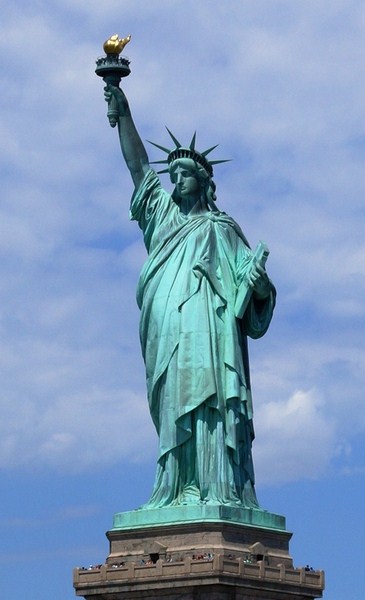
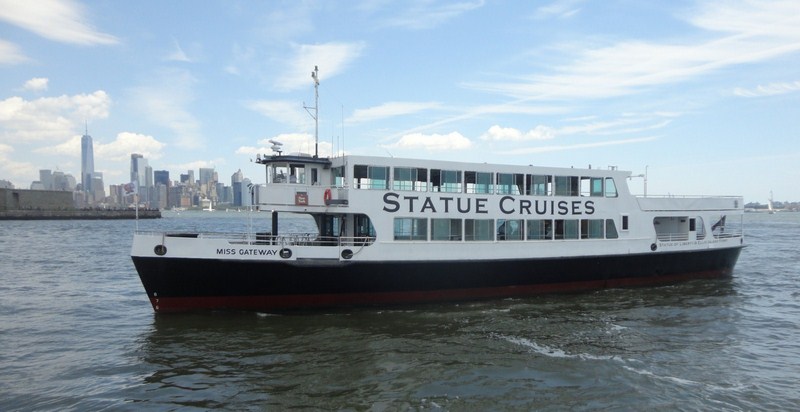
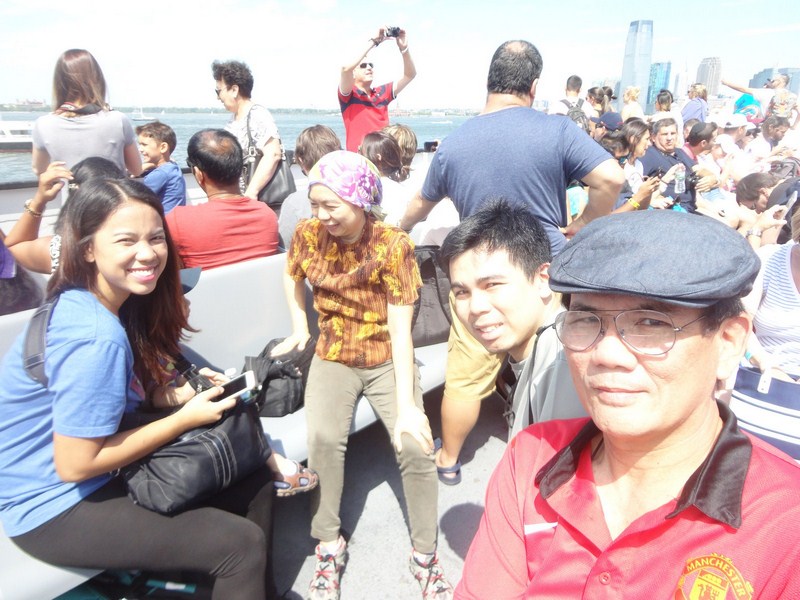

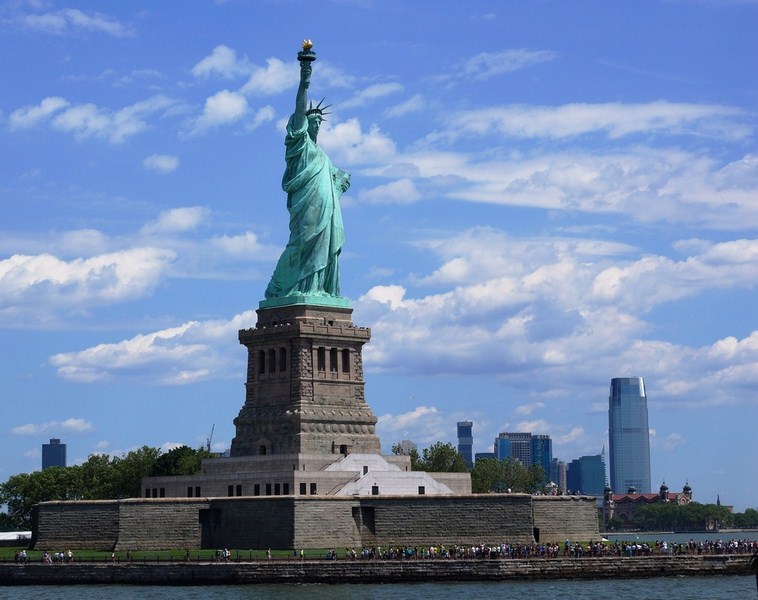



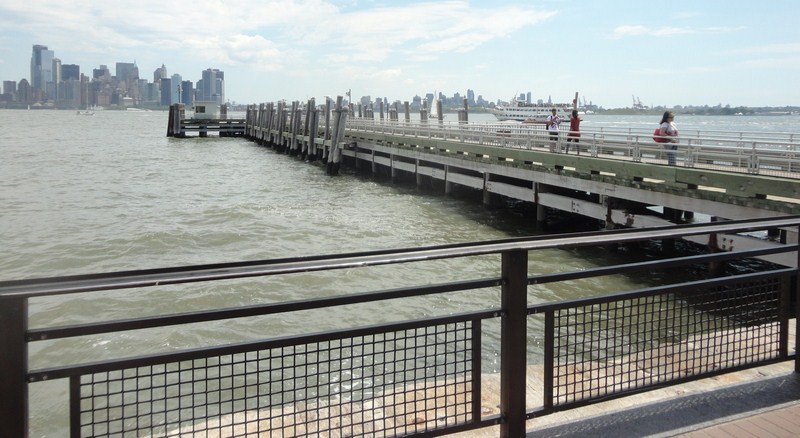
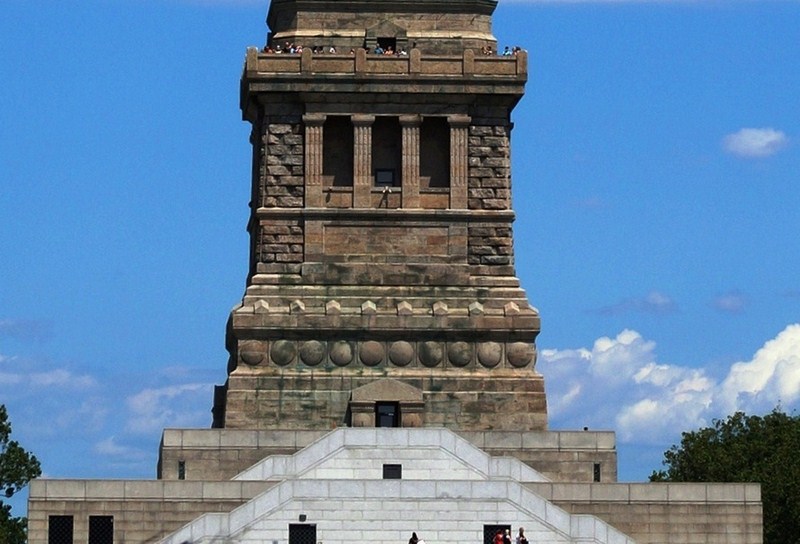


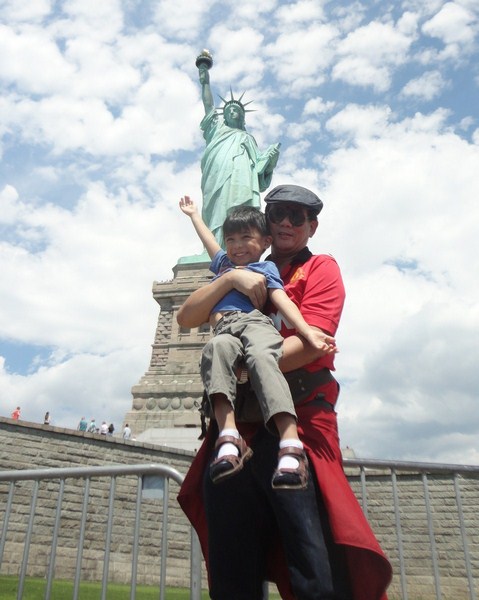
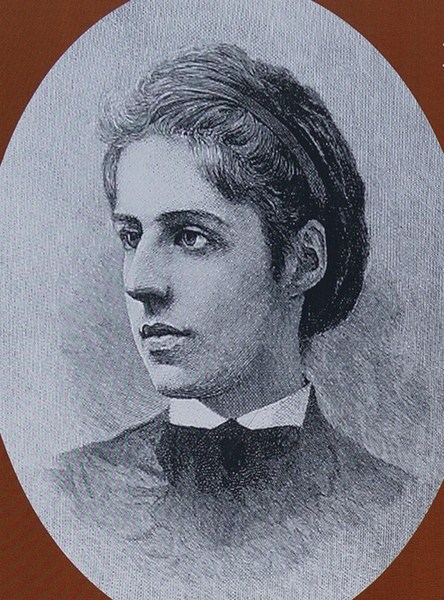
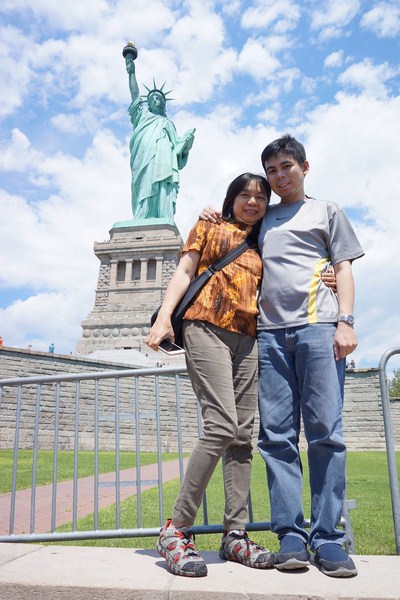


Pingback: Ellis Island National Museum of Immigration (New York City, U.S.A) – B.L.A.S.T. – Live Life to the Fullest ……… Don't Stay Put